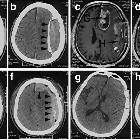calcified chronic subdural hematoma








Calcified chronic subdural hematomas are rare variants of chronic subdural hematomas.
Epidemiology
Calcified chronic subdural hematomas are uncommon, accounting for only 0.3-2.7% of chronic subdural hematomas . They are seen more commonly in children than in adults .
Clinical presentation
Clinical presentation varies significantly, with some patients being asymptomatic, while others have seizures, intellectual disability and dementia, focal neurological deficits, or features of raised intracranial pressure .
Pathology
The interval period between acute bleed and calcification varies from 6 months to many years, and most often occurs when the hematoma is due to head trauma . Importantly, only the periphery of the hematoma uniformly calcifies, the contents are gelatinous or clay-like in composition and consistency . In some cases, the periphery of the hematoma eventually ossifies, known as an ossified chronic subdural hematoma .
The precise mechanism by which the periphery of some subdural hematomas calcify while others do not has not yet been determined, but is likely to be multifactorial involving both vascular and metabolic factors .
Radiographic features
Plain radiograph
Plain radiograph of the skull shows a dense calcified mass lesion that follows the curvature of the skull and crosses suture lines .
CT
CT brain has classically been the imaging modality of choice and characteristically shows an extra-axial crescent-shaped or bi-convex-shaped hypodense mass with thick hyperdense calcific margins that crosses suture lines . The calcific hematoma capsule often adheres to the leptomeninges and underlying cortical surface, and causes a degree of mass-effect . When present bilaterally, the colloquialisms "Matrioska head” or “armoured brain” are often employed to describe the 'double skull' appearance .
MRI
MRI brain shows the same characteristic lesion as CT, where the hemorrhage and surrounding calcific capsule demonstrates the following signal intensities :
- T1: hematoma is isointense to CSF, the capsule is hypointense to CSF
- T2: hematoma is isointense to CSF, the capsule is hypointense to CSF
- FLAIR: hematoma is hyperintense to CSF, the capsule is isointense to CSF
While calcification is not as prominent on MRI as it is on CT, at least one study has utilized MRI pre-operatively to assess the degree of adherence between the calcification and underlying structures by determining if there was any CSF-intensity signal between the margins of the calcific capsule and underlying brain on T2-weighted images . Such determination is not possible using CT .
Treatment and prognosis
Unlike non-calcified chronic subdural hematomas, neurosurgical excision of the hematoma can be problematic because the calcific hematoma capsule often adheres to the leptomeninges and underlying cortical surface, which means that removal of the calcification can damage the underlying cortex resulting in poor neurological outcome . Thus, neurosurgical intervention should be considered on a case-by-case basis, depending on the potential benefits of surgery and the degree of adherence the calcification has to underlying structures .
History and etymology
Calcified chronic subdural hematomas were first described at autopsy in 1844 by Bohemian pathologist Carl von Rokitansky (1804-1878) . Multiple studies incorrectly cite this discovery as happening in 1884 , but this is a date actually after von Rokitansky's death in 1878.
Differential diagnosis
- calcified subdural empyema
- causes of diffuse dural calcification
Siehe auch:
und weiter:

 Assoziationen und Differentialdiagnosen zu verkalktes subdurales Hämatom:
Assoziationen und Differentialdiagnosen zu verkalktes subdurales Hämatom:
